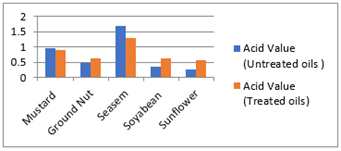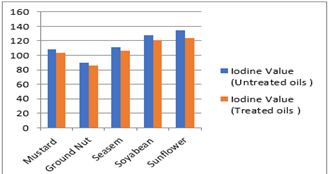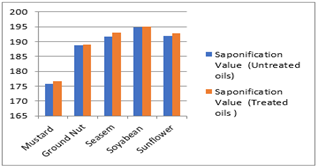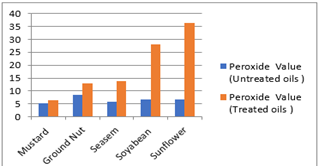Research Article
Comparative Chemistry of Mustard, Groundnut, Sesame, Soyabean and Sunflower Oils and Impact on Human Health
- Rashmi Sharma *
- Shekhar Kanwaria
Department of Chemistry, S.P. C. Govt. College, Ajmer, Rajasthan, India.
*Corresponding Author: Rashmi Sharma, Department of Chemistry, S.P. C. Govt. College, Rajasthan, India.
Citation: Rashmi S, Shekhar K. (2023). Comparative Chemistry of Mustard, Groundnut, Sesame, Soyabean and Sunflower Oils and Impact on Human Health, International Journal of Nutrition Research and Health, BRS Publishers. 2(1); DOI: 10.59657/2871-6021.brs.23.007
Copyright: © 2023 Rashmi Sharma, this is an open-access article distributed under the terms of the Creative Commons Attribution License, which permits unrestricted use, distribution, and reproduction in any medium, provided the original author and source are credited.
Received: April 10, 2023 | Accepted: April 24, 2023 | Published: May 01, 2023
Abstract
Chemistry of edible oils is very significant and plays an important role as a rich source of energy for human beings. Mustard (rapeseed), Groundnut (peanut) and Sesame (til) are natural oil seeds with highest content of mono unsaturated fatty acids (MUFA). They are naturally stable, healthy oils with natural antioxidants and fat-soluble vitamins A &E, which prevents them from rancidity & reversion.
Due to higher percentage of polyunsaturated fatty acids (PUFA) and presence of more double bonds Soyabean (drying) and Sunflower (semi drying) oils have greater tendency to oxidize in presence of sunlight, temperature, air and metal.
The physico chemical studies of about their chemical constitution and various parameters regarding quality of edible oils like Peroxide and Iodine value during heat treatment have been carried out and analyzed with a conclusion that higher PUFA content distort the quality of oil the most during thermal abuse and longer storage. The maximum deviation and distortion in peroxide values suggests that Soyabean and Sunflower oils should not be treated at high temperature. Thus, it may be emphasis that the selection of the oil in the diet should be done carefully and natural oil seeds should be preferred in diet for better health.
Keywords: traditional oils; natural oil seeds; healthy oils; mustard; seasam; PUFA; MUFA
Introduction
Edible oils have significant role in diet due to their interesting chemistry which needs to be discussed and analyzed with respect to their biochemistry, metabolism, degradation and impact on human health. Fats are one of the large groups of organic compounds and the major energy storage form in most of the body cells. We eat fats as edible oils and animal fat like ghee and butter because they are readily digested and utilized in the body. The chief contribution of fats and other lipids to the diet is their energy value and also satiety value. Fats are also acts as solvent sand source for the fat-soluble vitamins such as A, D, E, K and pro vitamin A, the carotene. Fats and other lipids also contribute essential fatty acids to the diet which body cannot synthesize [1].
Traditional and natural edible oils like sesame, mustard and groundnut oils are being used in cooking many food items, vegetables, deep frying and for storage purposes as pickles from a long time worldwide specially in eastern countries like India, China and Japan [2,3]. The virgin oil of these naturally oil rich seeds extracted through ecofriendly, cold pressing technique called ‘Ghani’ which extract the oil from seed very slowly at low velocity (which is an important factor to preserve the natural quality, components, specific colour, flavour and odour of the oil) at room temperature between 25-400C. The oil extracted through cold pressing technologies is fresh, the extracted oil is fresh, healthy, unadulterated, rich in antioxidants and vitamins. This pure oil is with natural specific flavour of taste, colour and aroma. These oils are more nutritious in all means, easily assimilated and digestive in human body to provide maximum benefits without causing any harmful effect on health.
Health and Chemistry of Edible Oils
According to literature of ancient Ayurveda, Sesame oil (rich in MUFA) is the best for edible purposes and which has been used as dressing oil on freshly cooked traditional food items made by regional food grains which are very nutritious in all means, though Mustard (highest MUFA) and Groundnut oils are not only healthy but possess medicinal properties as well [2-4] whereas Safflower oil (Highest PUFA) is said worst for eaten as an oil in India [2]. Literature survey reveals oil with higher poly unsaturation (PUFA Value) reacts more rapidly with air which may cause rancidity and reversion like phenomenon due to reactions like oxidative polymerization and hydrogenation during their thermal abuse and long storage [4-7]. Soyabean, Sunflower and Safflower oils have high content of PUFA. In-depth scientific studies of these oils support traditional (Ayurvedic) understanding and indicate that these new oils extracted through solvent extraction and treated chemically for bleaching and refining are not only undesirable but are harmful for health, especially in Indian cuisine where they are mostly used for frying and for pickles.
Table 1:Percentage fatty acid composition of some commonly used oils.
| Oil | Total% of oil Content in oil Seed | Saturated Fatty Acid (SFA) | Mono Unsaturated Fatty Acid (MUFA) | Poly Unsaturated Fatty Acid (PUFA) |
| Mustard | 43 | 6 | 73 | 21 |
| Groundnut | 47-55 | 20 | 54 | 26 |
| Sesame | 50 | 14 | 46 | 40 |
| Soyabean | 18 | 15 | 25 | 60 |
| Sunflower | 48-53 | 8 | 34 | 58 |
| Safflower | 20-30 | 11 | 13 | 76 |
Table 2:Major component acid (% wt.) of vegetableoils investigated.
| Nameof oil | SFA 8:0 | SFA 10:0 | SFA 12:0 | SFA 14:0 | SFA 16:0 | MUFA16:1 | SFA 18:0 | MUFA 18:1 | PUFA 18:2 | PUFA 18:3 | others |
| Ground Nut | — | — | — | — | 10 | — | 4 | 61 | 18 | — | C20-C24-7% |
| Mustard | — | — | — | — | 2 | — | 1 | 25 | 18 | 10 | 20:1-10 % |
| Sesame | — | — | — | — | 8 | — | 4 | 45 | 41 | — | — |
| Soyabean | — | — | — | — | 12 | — | 4 | 24 | 51 | 9 | — |
| Sunflower | — | — | — | — | — | 14 | — | 14 | 72 | — |
It is a well-known fact that Soybean, Sunflower and Safflower oils are extracted through different new technologies involving solvent extractions, bleaching, refinement etc by the use of number of harmful chemicals, and antioxidants have been added afterwards [4]. Five oils Mustard, Groundnut, Seasem, Soyabean and Sunflower have been taken and analysed to access the effect on the physico chemical parameters regarding quality of edible oils after treatment at high temperature (Above 1800C for an hour in iron pan) and tabulated the observations in Table 3 and plotted. [3,4,6] Further the parameters analysed using the plots (Fig 1-4). A perusal of Table 1 & 2 and literature survey suggest that oils with a higher percentage of polyunsaturated fatty acids (PUFA) such as Soybean, Sunflower and Safflower (highest content of PUFA) are may react very rapidly with oxygen of the atmosphere and produce peroxides, free radicals and many other lipid oxidized products which affects the lipid profile of human body and responsible for lowering levels of both harmful LDL cholesterol and useful HDL cholesterol. This fact has been further strengthening and supported by our studies about peroxide values of untreated and treated oils (Fig-4).
On the other hand, edible oils rich in monounsaturated fatty acids (MUFA) such as mustard, groundnut, and sesame lower harmful LDL cholesterol level without affecting useful HDL cholesterol and hence are better for balancing cholesterol profiles [3-13]. Oxidation products present in abused frying fats and oils are the compounds most suspected of impairing the nutritional properties of the oils or involving adverse physiological effects. The recent studies on their health implications include those related to their fate and those focused on their effects in metabolic pathways and the most prevalent diseases [13-15].
Table 3: Physico-chemical parameters of some Edible oils.
| Oil Untreated (Treated) | Acid Value | Iodine Value | Saponification Value | Per Oxide Value | Specific Gravity 40oC | Ref Index |
| Mustard | .97(.90) | 108.0(103.6) | 175.8(176.6) | 5.16(6.32) | .908(.912) | 1.4660(1.4666) |
| Ground Nut | .49(.62) | 90.18(85.67) | 188.7(188.9) | 8.55(13.0) | .911(.916) | 1.4628(1.4637) |
| Sesame | 1.7(1.3) | 111.1(106.2) | 191.7(193.1) | 5.97(13.7) | .916(.920) | 1.4660(1.4666) |
| Soyabean | .35(.64) | 127.4(121.4) | 194.8(195.1) | 6.7(28.0) | .920(.922) | 1.4699(1.4702) |
| Sunflower | .28(.57) | 134.7(123.7) | 191.9(192.9) | 6.7(36.4) | .917(.918) | 1.4710(1.4707) |
Figure: 1
Figure: 2
Figure: 3
Figure: 4
According to Table 2, the (PUFA) content of octadecenoic acid (Linoleic) is 51% in Soyabean & 72% in Sunflower whereas only 18% in Mustard and Groundnut oil. Besides this the content of octadecatrienoic acid (Linolenic) was 9 % in Soyabean oil whereas the trienes were totally absent in other oils. The (MUFA) contents of octadecenoic, hexadecenoic were 24, 28, 45 % and saturated fatty acids (SFA) 16, 0, 12 % in Soyabean, Sunflower and Sesame respectively [4]. The higher amount of polyunsaturated fatty acid present in Soyabean, Sunflower and Sesame oils make these oils more susceptible to oxidative polymerization under frying conditions.
Previous studies by various scientists show that the rate of cyclization, branching and polymerization of fatty acids is faster at higher temperature of frying than at lower temperatures. The results of various studies also suggest that antioxidants are almost ineffective in retarding the degree of polymerization in Soyabean and Sunflower at frying temperature [3,4,6]. Physico chemical studies for Acid value, Iodine value, Saponification value, Peroxide value, Specific gravity and Reference Index were done for untreated and heat-treated samples of referred oils and findings have been tabulated in Table 3.
The iodine value decreased for all the samples could be attributed to the constant destruction of double bonds with the development of polymeric fractions. Soyabean oil because of more methylene interrupted unsaturated groups provides more active centers for conjugation which in turn facilitate the formation of polymers (Table -3, Fig -2). The saponification value of frying oil increases maximum for Sesame, Soya and Sunflower. The higher saponification value, encountered in these oils indicates the formation of more and more low molecular weight composition products in the oil during successive frying (Table -3, Fig 3).
The peroxide value of the frying oil increases indicative of degree of deterioration due to reaction with atmospheric oxygen and many peroxides and lipid oxidized products were produced during thermal abuse of oil with high content of PUFA and was also observed by other workers. The studies suggested that maximum deviation in quality occurred in Soyabean and Sunflower oils on treatment at higher temperature (Table -3, Fig 4). All the above results indicate and suggest a higher degree of deterioration due to presence of higher poly unsaturation in conjugation and ineffectiveness of antioxidants at higher temperatures in Soyabean and Sunflower oils. [3,4]. Some chain cleavage products from fatty acids disturbs endothelial cells and induces several Genotoxic effects in hepatocytes and lymphocytes [10]. Thus, it may be suggested that the chemistry plays a significant role and affects the human health [13-15].
Moreover, literature survey also reveals that additional cholesterol-reducing properties are likely to come from the natural plant sterols and stanols contained in oils extracted without heat or solvents [3,4,16]. Sesame contains 594mg/100g of soluble phytosterols while groundnut contains 247mg/100g and olive oil 210mg/100g. Soya and corn oils also contain phytosterols when raw (380mg/100g and 580mg/100g respectively), but since these latter need solvent or heat for extraction, the sterols are invariably lost in processing [3,16].
In Western countries rancidity and reversion of refined oils such as soybean oil were initially remedied by hydrogenation. More recently, with growing evidence of the harmfulness of trans-fatty acids, rancidity and reversion are increasingly being prevented by the addition of antioxidants [11,12]. However, according to studies conducted on soybean oil by V.K. Tyagi and Pramod Kumar at Kanpur, deterioration of nutritional quality at high frying temperatures is rapid and added antioxidants are almost ineffective at retarding this [17, 18].
Vegetarians can easily achieve n-6/n-3 ratio and ALNA (α-linolenic acids) intake by using ALNA rich edible oil like yellow Indian Mustard as the cooking medium and also by increasing the intake ofALNA rich foods such as Mustard, Groundnut and Sesame oils freshly extracted through cold pressing method in the diet [19-44].
Conclusion
Chemical constitution of edible oils directly affects the human health due to its significant role in metabolism. Mustard (rapeseed), Groundnut (peanut) and Sesame (til) are natural oil seeds with highest content of mono unsaturated fatty acids (MUFA) and they are naturally stable healthy oils which are easy to process at small scale decentralized levels with eco-friendly and health friendly technologies. They are stable naturally due to presence of abundant number of natural antioxidants. All these oils have a lesser tendency to oxidize and deteriorate in presence of sunlight, temperature, air and metal which prevents them from rancidity & reversion.
On the other hand, refined Soyabean is drying oil and sunflower oil is semi drying oil. Due to higher percentage of polyunsaturated fatty acids (PUFA) and presence of double bond they have greater tendency to oxidize in presence of sunlight, temperature, air and metal. These oils have been extracted through solvent extraction technologies with hydrocarbon solvents such as Hexane, the other processes like bleaching and refinement also include number of hazardous chemicals. In the process of refining using alkaline solution, bleaching and finally de-odorizing process, most of the useful lecithin, tocopherols, vitamins and phytosterols are removed during various treatments given to the oils. Thus, it may be emphasis that the selection of the oil in the diet should be done carefully and natural oil seeds like Mustard, Groundnut and Seasem with natural colour due to vitamins A &E and aroma should be preferred in diet for better health.
Acknowledgement
Authors are highly thankful to the Principal, Head of the Department, S.P.C.G.C. Ajmer, Shri K. K. Agrawal from Bharatpur, Colleagues and UGC for Support.
References
- Van Holde, Ahern, (2005). Biochemistry 3rd Edition Mathews. Pearson Education Pub.
Publisher | Google Scholor - Charak Sanhita Part I (1975). Jaynendra Press New Delhi 27:249. Note:
Publisher | Google Scholor - Meyer, L.H. (1960). Food chemistry. Litton Educational Publishing, Inc. USA.
Publisher | Google Scholor - Gunstone, F.D. (1958). An Introduction of the Chemistry of Fats and Fatty Acids
Publisher | Google Scholor - Champman & Hall Ltd. London
Publisher | Google Scholor - Sharma, R. and Khan, S. (2007). Health aspects of traditionally processed indigenous edible oils. Recent Progress in Medicinal Plants, Natural Products-II, Stadium, Press LLC, U.S.A. 18:430
Publisher | Google Scholor - Sharma, R. R. Bhutra, S. Acharya and M.R.K. Sherwani (2007). Comparative analysis of four edible oils for stability against longer storage and heat deterioration during frying. J. lipid sci and Technology, 39:3.
Publisher | Google Scholor - Hildich, T.P. and P.N. William (1964). Chemical Constitution of Natural Fats. 4th edn. Chapman & Hall, London.
Publisher | Google Scholor - Tewfilk, I.H. H.M. Ismail, S. Sumar (1998). The effect of Intermittent heating on some chemical parameters of refined oils used in Egypt. A Public health nutrition concern. Int. J. Food Sci. Nutr. 49:339.
Publisher | Google Scholor - Goburdun, D. and B. Jhuree (1995). Effect of deep fat frying on fat oxidation in soyabean oil. Int. J. Food Sci. Nutr. 46:363.
Publisher | Google Scholor - Esterbauer H. (1993). Cytotoxicity and genotoxicity of lipid-oxidation products. Am. J. of Clinical Nutrition 57:7795.
Publisher | Google Scholor - Woodside, J.V. and I.S. Young (2001). Dietary antioxidants and protection from coronary heart diseases. In: Nutritional Health: Strategies for disease prevention. Eds: Wilson, T. and Temple, N.I. Humana Press, Totowa, U.S.A.
Publisher | Google Scholor - Byers, T. (1997). Hardened fats, hardened arteries? New England Journal of Medicine 337:1543-1545.
Publisher | Google Scholor - Ascherio, A. Katan, M.B. and Stampfer, M.J. (1999). Trans fatty acids and coronary heart diseases. New England Journal of Medicine 340:1994-1998
Publisher | Google Scholor - Carmen Dobarganes and Gloria Ma´rquez-Ruiz2(2015). Possible adverse effects of frying with vegetable oils. British Journal of Nutrition. 113:49-57.
Publisher | Google Scholor - Marta, D. Aleksandra, Z Izabela N, (2015). Lipid oxidation products as a potential health and analytical problem, CHEMIK (69)2:89-94.
Publisher | Google Scholor - Law, M. (2000). Plant sterol and stanol margarines and health. BMJ. 320:861-864.
Publisher | Google Scholor - Tyagi, V.K. and Vashishtha, A.K. (1994) Effect of deep fat frying on the characteristics and composition of soyabean oil. J. Oil Technologist's Association of India, 26:111
Publisher | Google Scholor - Tyagi, V.K. and Pramod Kumar (1995) Formation of polymeric fractions in frying fats. J. Oil Technologist's Association of India. 26:363
Publisher | Google Scholor - Shiva, V. (2000). Stolen Harvest: The Hijacking of the Global Food Supply. South End Press, Cambridge, MA.
Publisher | Google Scholor - RangaSwamy Baby Latha, Prabhdial Singh and Nasirullah (2008). J. Lipid Sci and Technology, (40)2:59-64.
Publisher | Google Scholor - Nasirullah and Rangaswamy Baby latha (2009) J. Lipid Sci and Technology,41.
Publisher | Google Scholor - Nagendra Prasad MN, Sanjay KR, Prasad DS, Vijay N, Kothari R, Nanjunda Swamy S (2012). A Review on Nutritional and Nutraceutical Properties of Sesame. J Nutr Food Sci. 2:127.
Publisher | Google Scholor - Collinge W, American Holistic Health Association (1996) The American Holistic Health Association Complete Guide to Alternative Medicine. Warner Books, New York, USA.
Publisher | Google Scholor - Nagendra Prasad MN, Sanjay KR, Deepika S. Prasad, Neha Vijay, Ruchika Kothari et.al. (2012). A Review on Nutritional and Nutraceutical Properties of Sesame. Omics publication group,2:127
Publisher | Google Scholor - Chavali SR, Zhong WW, Utsunomiya T, Forse RA (1997). Decreased production of interleukin-1-beta, prostaglandin-E2 and thromboxane-B2, and elevated levels of interleukin-6 and -10 are associated with increased survival during endotoxic shock in mice consuming diets enriched with sesame seed oil supplemented with Quil-A saponin. Int Arch Allergy Immunol. 114:153-160.
Publisher | Google Scholor - Wendy G. White, Stephen P. Moose, Clifford F. Weil, et.al. (2010). Tropical Maize: Exploiting Maize Genetic Diversity to Develop a Novel Annual Crop for Lignocellulosic Biomass and Sugar Production. Springer, 167-179.
Publisher | Google Scholor - Moazzami AA, Kamal-Eldin A (2006) Sesame seed is a rich source of dietary lignans. J Am Oil Chem Soc 83:719-723.
Publisher | Google Scholor - El Tinay AH, Khattab AH, Khidir MO (1976). Protein and oil compositions of sesame seed. J Am Oil Chem Soc 53: 648-653.
Publisher | Google Scholor - Noon DD (2003). Sesame Oil Benefits Blood Pressure Cooking Oil Switch May Be High Blood Pressure Treatment, Inter-American Society of Hypertension. Yale J Biol Pred., Sankar D et al. (2006) March Department of Bio Technology, Vinayaka Mission Research Foundation University, Paiyanoor chennai, Tamilnadu J. Nutr. Sci Vitaminol (Tokyo), 51 (4).223-230
Publisher | Google Scholor - J Med. Food (2005). Fall, 18(3):377-381.
Publisher | Google Scholor - Alcohol Clin. (2005). Exp. Res, 29 (11):116-120.
Publisher | Google Scholor - N.F.B. Alves, S.K.P. Porpino, M.M.O. Monteiro, E.R.M. Gomes, and V.A. Brag (2015). Appl. Physiol. Nutr. Metab. 40:393-400.
Publisher | Google Scholor - Wendy E. Ward, Phil Chilibeck. (1993). Applied physiology nutrition and metabolism. Canadian science publiations.
Publisher | Google Scholor - T. A. V. Nguyen, Truong D. Le, Hoa N. Phan, and Lam B. (2018). Hydrolysis Activity of Virgin Coconut Oil Using Lipase from Different Sources. hindawi. scin.
Publisher | Google Scholor - Mirzaei F, Khazaei M, Komaki A, Amiri I, Jalili C. (2018) Food Chem Toxicol. May. (2) 118:68-83.
Publisher | Google Scholor - Nafar, Firoozeh, Mearow, Karen M. (2014). Journal of Alzheimer's Disease. (39) 2:233-237.
Publisher | Google Scholor - Abraham Samuel Babu, MPT, Sundar Kumar Veluswamy, MPT, Ross Arena, (2014). Postgraduate Medicine, 126:7.
Publisher | Google Scholor - Peanuts: Worlds Healthiest foods, (2014). The influence of herbs and spices on overall liking of reduced fat food. Wh foods. Com. 183-189.
Publisher | Google Scholor - Sanders, TH; Mc Micheal Jr., RW; Hendrix, KW (2000)
Publisher | Google Scholor - Coenzyme Q 10 (2017). American Cancer Society. 20(7):11-18.
Publisher | Google Scholor - Shyam Prakash et al (2003). Clinical Versatility of Autoioxidants and w-6/w-3 PUFA content in Edible Vegetable Oil. National Convention on Health, Nutrition and value Addition, 5:22.
Publisher | Google Scholor - Priya Bhargava, Tarachand, (2005), Food and Nutrition, Commen Wealth Publishers, 209-227.
Publisher | Google Scholor - R. Sharma, (2008). India's colourless revolution. Bioscience resourse project.
Publisher | Google Scholor


















